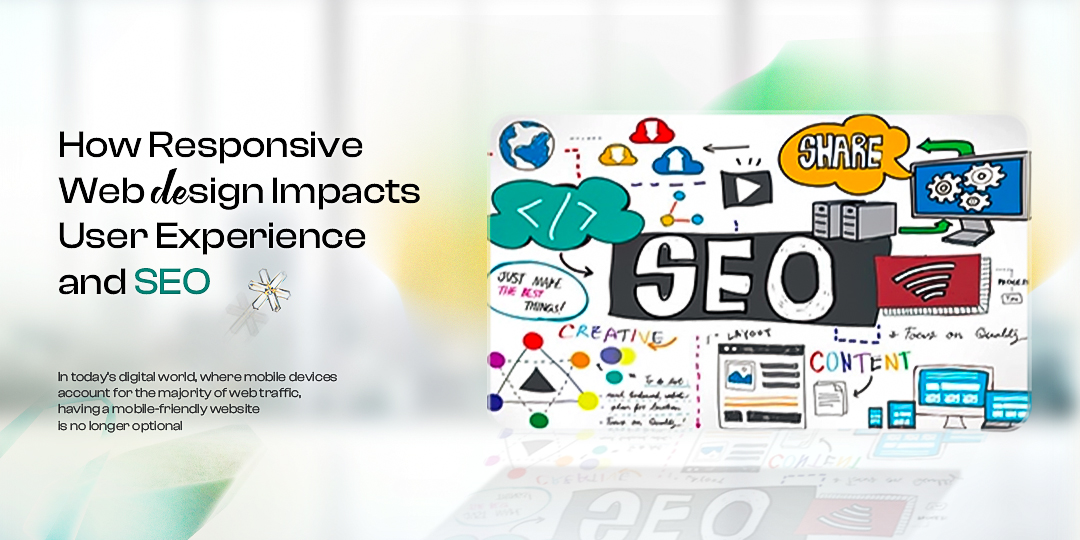How Responsive Web Design Impacts User Experience and SEO
November 3, 2025

In today’s digital world, where mobile devices account for the majority of web traffic, having a mobile-friendly website is no longer optional. Responsive web design (RWD) plays a critical role in ensuring your website is accessible, functional, and user-friendly across all devices and screen sizes. Not only does it improve user experience, but it also significantly impacts your website’s SEO rankings. In this article, we’ll explore how responsive web design enhances user experience and its direct influence on SEO.
1. What is Responsive Web Design?
Responsive web design is an approach to web design and development that ensures a website adapts seamlessly to various screen sizes and devices, including desktops, tablets, and smartphones. By using flexible layouts, images, and CSS media queries, responsive web design adjusts the content and layout according to the user’s device, ensuring an optimal viewing experience.
A mobile-friendly website is an essential component of responsive design. With responsive web design, a single website can automatically resize and reorganize itself to provide the best possible experience for users, regardless of the device they are using.
2. How Responsive Web Design Improves User Experience
User experience (UX) is a crucial factor in determining the success of your website. A positive UX leads to increased engagement, higher conversion rates, and better customer satisfaction. Responsive web design plays a significant role in enhancing UX by ensuring that users have a consistent and seamless experience across all devices.
Key UX Benefits of Responsive Web Design:
- Consistency Across Devices: With a responsive website, users can expect the same look, feel, and functionality across any device. Whether on a desktop, tablet, or smartphone, the content is presented in a user-friendly and easy-to-navigate format.
- Faster Load Times: A responsive design optimizes images and content to load faster on mobile devices, improving user satisfaction. Slow-loading pages can lead to higher bounce rates, as users are less likely to stay on a page that takes too long to load.
- Mobile-Friendly Navigation: Navigation is an essential aspect of user experience. Responsive web design simplifies navigation on mobile devices, ensuring menus are easy to use and content is easy to find.
- Improved Accessibility: A responsive design ensures that all users, regardless of the device they’re using, can access your website’s content. This is crucial for users with disabilities, as a well-designed responsive website often includes features like accessible navigation and text resizing.
3. Impact of Responsive Web Design on SEO
In addition to enhancing user experience, responsive web design also has a significant impact on your website’s SEO performance. Google and other search engines prioritize mobile-friendly websites and consider responsive design a best practice for SEO. Let’s look at how responsive design affects SEO:
a. Mobile-First Indexing
In 2025, mobile-first indexing is the standard for search engines like Google. This means Google predominantly uses the mobile version of your website to rank your pages. If your website is not responsive and doesn’t provide a good mobile experience, it could negatively impact your SEO rankings.
Why It Matters:
- Rankings Based on Mobile Version: Google crawls and indexes the mobile version of your site first. If your website is not mobile-friendly, your rankings could suffer, even if the desktop version performs well.
- Increased Mobile Usage: With mobile usage continuing to rise, having a responsive design ensures your site is optimized for the growing number of mobile users, which can boost your visibility in search results.
b. Single URL for All Devices
Responsive web design uses a single URL for both desktop and mobile versions of your site, which simplifies your SEO efforts. In contrast, websites that use separate mobile and desktop versions (e.g., a mobile subdomain like m.example.com) may struggle with duplicate content issues and link equity fragmentation.
Benefits for SEO:
- Avoids Duplicate Content Issues: A single URL ensures that search engines only need to index one version of your content, reducing the risk of duplicate content penalties.
- Consolidates Link Equity: With a single URL, all your backlinks point to one page, consolidating link equity and improving your chances of ranking higher in search results.
- Simplified Tracking and Analytics: Having one URL for all devices makes it easier to track user behavior, traffic, and conversions using tools like Google Analytics, providing more accurate insights for SEO optimization.
c. Improved Site Speed
Responsive web design ensures that your website is optimized for speed, which is a crucial factor in SEO. Search engines like Google prioritize fast-loading websites, especially for mobile users. A responsive site typically delivers better performance by optimizing content for mobile devices, reducing page load times and improving overall user experience.
Why Site Speed Matters for SEO:
- Lower Bounce Rates: Faster websites result in lower bounce rates. If users can quickly access your content, they are more likely to stay on your site, reducing bounce rates and improving your rankings.
- Higher Conversion Rates: Faster sites also have better conversion rates. When users don’t have to wait for pages to load, they are more likely to complete actions such as making a purchase or filling out a contact form.
d. Better Crawlability and Indexing
Responsive web design ensures that search engines can easily crawl and index your content. Since there’s only one version of your website, search engines don’t need to crawl separate versions for desktop and mobile. This makes it easier for search engines to understand and rank your content.
Benefits for SEO:
- More Efficient Crawling: Search engines can crawl and index your website more efficiently, allowing them to quickly update their index with your latest content.
- Avoids Duplicate URLs: Using a single URL for all devices eliminates the risk of creating duplicate URLs for the same content, which could hurt your SEO performance.
4. Responsive Web Design and User Engagement
A responsive website leads to higher engagement from users. When visitors have a positive experience on your site, they are more likely to explore your content, stay longer, and convert into customers. These engagement metrics—such as time on site, pages per session, and click-through rates—are all factors that search engines consider when ranking websites.
How Responsive Design Enhances Engagement:
- Better User Retention: A smooth, consistent experience across all devices increases the likelihood that users will return to your website, improving retention rates.
- Higher Click-Through Rates: A responsive design with optimized mobile navigation encourages users to explore more pages on your site, leading to higher click-through rates and improved SEO.
- Improved Conversion Rates: When users find it easy to interact with your site, whether it’s filling out a form or making a purchase, conversion rates increase, positively impacting your website’s performance in search rankings.
5. Conclusion
Responsive web design is not only a best practice for improving user experience, but it is also a critical factor in SEO. A responsive site ensures that your website is mobile-friendly, fast, and easy to navigate, which enhances user engagement and boosts your chances of ranking higher in search engine results. With mobile-first indexing becoming the standard and the growing importance of a seamless user experience, responsive design is a key strategy for businesses that want to succeed online. By implementing responsive web design, you can improve your website’s usability, increase your visibility in search results, and provide a better experience for all users, regardless of the device they are using.
Share
.jpg)

